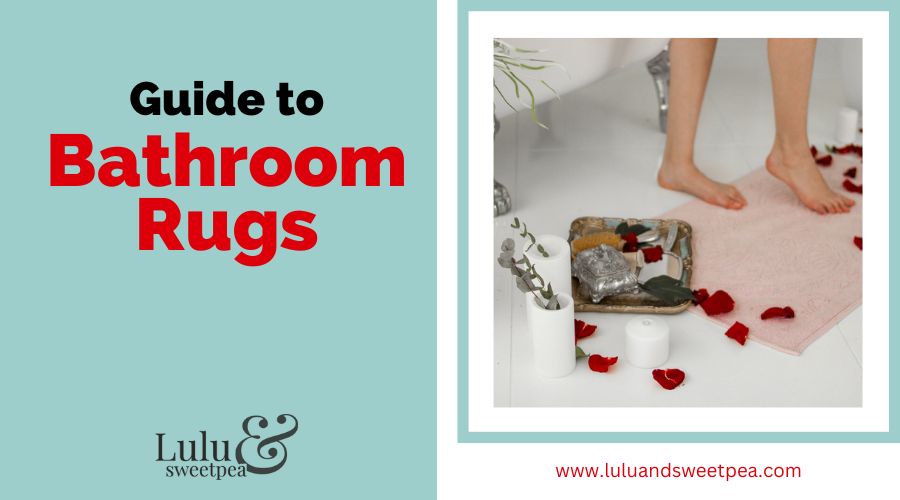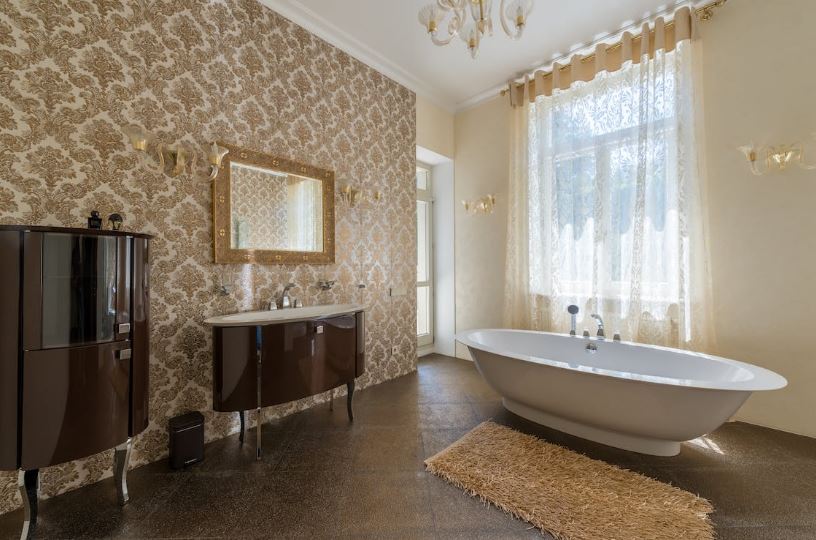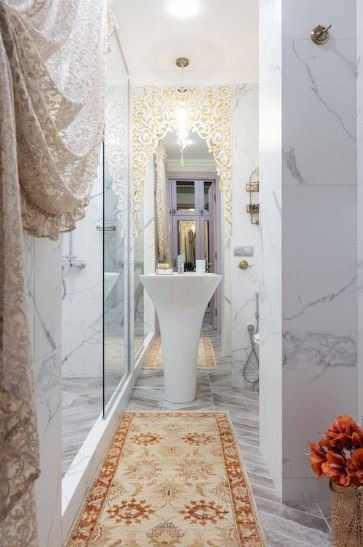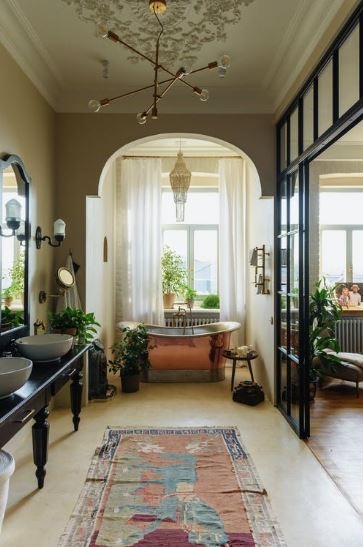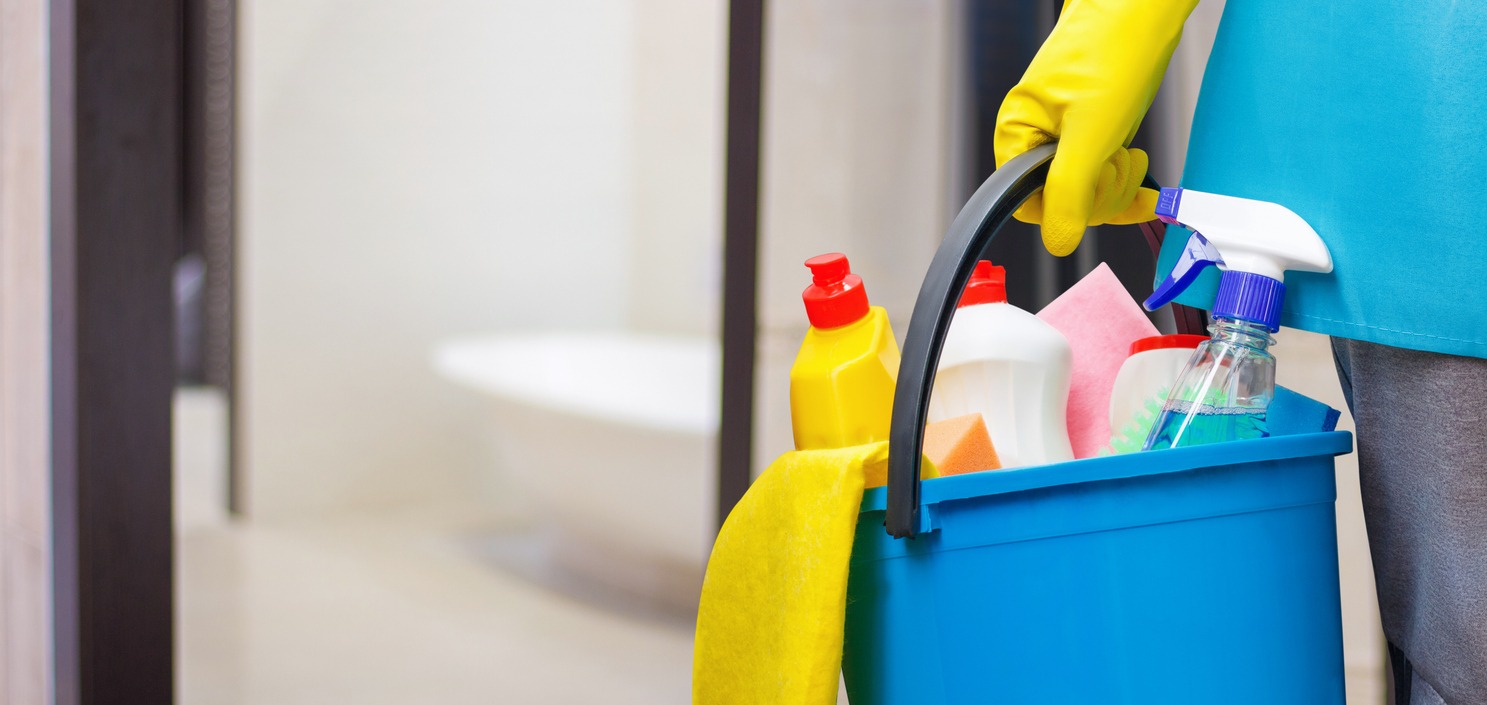Bathrooms can sometimes appear bare and unwelcoming because of their glossy tiles. This is why bathroom rugs are included as an interesting accent to the bathroom’s overall interior design.
Bathroom rugs offer color and warmth to floors that are otherwise frigid. They are employed to make the bathroom more comfortable and “homey.”
Should Your Bathroom Include Rugs?
Having a rug in the bathroom is highly recommended. Bathroom carpets can serve numerous purposes.
First, they add an additional layer of design to the bathroom by coordinating with the shower curtain, towels, or any other soft fabric that may be present.
Additionally, bathroom rugs give a smooth landing for your feet in front of the sink and mirror, as well as close to the shower or bathtub.
Lastly, they absorb water and avoid slippage when the floor is wet.
The amount of carpets required in a bathroom varies on the bathroom itself. Remember to never cover the entire bathroom floor with carpets, as this may encourage mold growth.
It is typical for a bathroom to have two to three rugs. These can be put in front of the sink, the bathtub or shower, and if there is sufficient space, even in the center of the bathroom.
Advantages of Buying a Bathroom Rug
- Stylish – A bathroom rug is a certain way to make a statement. A well-maintained bathroom rug may be a focal point and a fashionable addition to your house. When you’re in the mood for a change, adding a rug is a terrific way to easily update your bathroom without having to overhaul the entire concept.
- Comfort – The only thing that could improve a wonderful shower at the end of a hard day is stepping out onto a beautiful, plush rug. This is likely one of the most obvious and widely acknowledged advantages of bathroom carpets. Even if you are not taking a shower, this is a preferable alternative to a tile or laminate floor. In addition, having a rug in your bathroom is an excellent approach to lessen the risk of slipping, particularly if your tiles are unsuited for a moist environment. Consider utilizing a nonslip underlay or selecting a rug with a nonslip backing.
- Cost – If you prefer to frequently redesign portions of your home, the bathroom is a smart choice because it tends to be smaller than other rooms and is subject to greater wear and tear. With a rug, it is simple and inexpensive to make rapid design adjustments. Bathroom rugs are an excellent way to refresh a space without having to remove tiles from the walls or call a plumber.
Negative Aspects of Buying a Bathroom Rug
- Hygiene – This is likely the most obvious argument against having a bathroom rug. You must be vigilant for mold, mildew, and spills. It is feasible to utilize rugs and carpets in the bathroom as softer floor surfaces have become increasingly popular over time. Unlike small carpets, which are far more difficult to clean and maintain, small rugs can be simply washed or changed, making them a perfect option to add a softer, cozier look to your bathroom without the hassle of maintaining a carpet.
- Deterioration – The majority of carpets are not intended for prolonged contact to water and other forms of moisture. The padding will certainly deteriorate and begin to dissolve over time. This is another issue that may be prevented by monitoring the condition of your rug and taking action before the problem becomes severe. As you would with a bath mat, throw your rug in the washing machine every few weeks and clean up spills to prevent the pile from being damaged.
How to Select the Ideal Bath Rug?
Choosing a rug for your bathroom may appear to be a simple chore, but it may have a significant impact on the overall appearance of the room, as well as on the safety of you and your family, and even on your daily routine. In general, when buying for a bathroom rug, it’s crucial to examine the rug’s color, size, material, longevity, necessary care, and any other safety measures it offers, so you should prepare to account for a number of factors.
Start by measuring the complete bathroom and the area where you intend to lay the rug, which is typically the room’s center or the space in front of the bathtub, so that the piece can avoid slipping on the tile floor. If you get a rug that is too small, it may appear out of place, and it could pose a safety risk if water falls onto the tile when you exit the shower or tub. If you choose a mat that is overly large, it may not lay flat around your bathroom fixtures and it may also dominate the area or detract from other decor. Your dimensions will also help you decide if you want a rectangle, square, round, or abstract-shaped rug. Typically, rugs measuring 17″ by 24″ can be placed in front of pedestal sinks or shower stalls, and rugs measuring 21″ by 34″ can be placed outside the majority of bathtubs.
Consider colors next. The bathroom is just as significant as any other room when it comes to home decorating, especially if it opens onto the master bedroom or if it’s a powder room that allows you to coordinate with the rest of the house’s decor. You can choose plain colors or exotic patterns, but your bathroom mat should unify the space, complement the bathroom’s general design, and reflect your distinct individuality. Patterns look better on smaller rugs since they do not overwhelm the eye.
You may, for instance, choose to transform your bathroom into a spa-like space with soothing blue and green tones meant to evoke the colors of the ocean. A solid color or pattern consisting of basic geometric forms in these hues may be the optimal choice. Or you may want to complement the soft, feminine design of your bedroom with your bathroom. In this situation, you could select a flowery rug in pastel hues. Your bathroom rug should include the colors of your shower curtain, window curtains, towels, and any other colors utilized in the area.
When selecting a material, you should also consider its ease of care. Consider whether it can sit in your hamper for a few days before being placed in the washing machine, or if it requires more attention. The more manageable something is, the better it will be for your daily schedule.
Consider your bathroom rug’s safety features as a last consideration. If young children will be walking on it, you should ensure that it does not become slippery when wet. You should also evaluate whether or not the rug is anti-bacterial and whether or not it incorporates memory foam for additional support and comfort. You may also use carpets manufactured from organic materials to give your bathroom an eco-friendly touch.
Types of Bathroom Rugs
The bathroom rug is typically put close to the tub, shower, and/or vanity for comfort and non-slip safety. If your bathroom is spacious, you may have many rugs. If you play your cards well, you can use the mats to enhance the aesthetic of your bathroom.
Many materials can be used to create contour rugs, but bamboo, cotton, polyester microfiber, chenille, and nylon are the most frequent and safest for bathroom floors. Choosing a material is one of the most significant aspects of selecting a bathroom contour rug, for both safety and aesthetic reasons. Every day, toilet rugs will be exposed to water and moisture, therefore they must be absorbent and quick-drying so that they do not become breeding grounds for bacteria.
1. Cotton
Cotton is a widely used material for a variety of household products. It is a highly absorbent textile that quickly dries in most situations. Cotton is also one of the softer options for bathroom rugs, and it is widely acknowledged to be the easiest to clean. In the same vein, Egyptian cotton is an alternative. It possesses the same fundamental properties as conventional cotton, but is more absorbent and notably softer to the touch. Depending on the fabric’s weave and design, the majority of cotton rugs may be washed in a standard washing machine cycle, making it simple to keep your bathroom clean.
2. Chenille
Chenille is not as soft as cotton, but it is more water- and water-damage-resistant. This material is similar to cotton in all other respects and provides a touch of luxurious luxury to any bathroom.
3. Nylon
In addition to being one of the most durable fabrics for a bathroom rug, nylon is also machine-washable. Although nylon is not as soft as cotton, it is still a highly pleasant material that is ideal for any bathroom. Its absorbency is significantly less effective than that of cotton, but it dries slightly faster.
4. Microfiber
As a synthetic alternative for a variety of fabrics, microfiber materials are gaining popularity. Microfiber goods absorb moisture, dry rapidly, reduce slipping, and are often durable. Depending on its style (e.g., flat versus plush), this material can be one of the softest possibilities for a bathroom rug. Microfiber is designed to keep floors clean and dry. Additionally, it is machine-washable, so your cleaning routine is not complicated for the sake of a single bathroom rug. Certain synthetic qualities of microfiber can cause skin allergies or moderate discomfort in individuals with sensitive skin; nevertheless, there are options for hypoallergenic microfiber.
5. Bamboo
As an alternative to conventional bathroom rugs, bamboo mats are becoming increasingly popular while being far less prevalent (and some companies do make them to fit around toilets). Since bamboo mats are made completely of wood, they do not absorb nearly as much moisture as fabric carpets. In conventional fabrics, excessive absorption and insufficient drying can result in mildew and other unpleasant bacterial odors.
Bathroom Rug Design Suggestions
- Selecting a rug for your bathroom may appear to be a difficult undertaking, as not all rugs are ideal for moist environments. Consider carpets made of synthetic fabrics and those that are machine-washable in lieu of those that require professional cleaning.
- A particularly large rug in the bathroom could be impractical, especially if it ends up in close proximity to the toilet, sink, bath, and/or shower. Select a modest to medium-sized rug to achieve this appearance.
- When it comes to fashion, the alternatives are practically limitless. Runners made from natural fibers, such as jute or sisal, would work well in a bathroom. The flat weave style is also great because it does not retain dust or moisture. In fact, some contemporary bath mats are constructed from jute, making this an excellent option. If you want to create a Scandi-style bathroom, jute is an excellent choice, as this natural texture and warm color would complement this trend and elevate all white bathroom suites. However, Jute and sisal rugs are typically only wipe-clean, so avoid this option if you desire a rug that can be washed.
- A shaggy rug could be an excellent choice if you envisioned a super-fluffy, sink-your-feet-into-it carpet. Choose one manufactured from synthetic material rather than one made from wool. Shaggy rugs are available in a variety of hues, allowing you to choose between something bright or something with a more natural feel in cream, white, and grey tones.
- The bohemian interior design trend is expected to become even more popular this year, and a Moroccan rug is the ideal way to give your bathroom a Bohemian vibe. If you want to add interest, texture, and color to the bathroom, a rug with a Moroccan pattern is a fantastic choice. Invest in complementary bathroom towels to complete the ensemble. To create a unified appearance, choose a color from your bathroom rug and incorporate it into your bath and hand towels, as well as any other bathroom accessories you may wish to replace.
Cleaning Bathroom Rugs
Why bathroom rugs are the most frequently used carpets is common knowledge. These rugs are also susceptible to significant wear and tear. How long should you wait before washing your bath mat is one of the most commonly requested questions. The amount of foot traffic a rug receives differs from residence to residence and family to family. Therefore, if a rug resides in a home with a large number of children and family members, cleaning the bath rugs should be a frequent responsibility of the owner. Once every one to two weeks, you should clean your rug. If there are fewer members and less foot traffic, every two to three weeks is sufficient to clean your rug.
Now that you know how often you should clean your bath rugs, let’s go over some of the basics of cleaning them. Start by patting the back of the rug with your hand, as has been done for ages. When you pat the back of the rug, you will be astounded by the amount of filth and dust that it expels. You won’t notice it on a daily basis, and you won’t notice it until after your first cleaning. Inspecting the rug’s tag is another vital initial step. You should determine if there are any materials that should not be used on the rug or that could be harmful to it.
The primary cleaning technique is simple. The only requirements are detergent, water, and a brush. Simply soak the rug and apply detergent to clean it. Avoid using too much detergent, as this can damage the rug’s fibers or strands. As previously said, ensure that the product you are using meets the rug’s specifications and description. Then, use the brush to carefully remove any dirt and dust from the rug, ensuring that it is well cleaned. After brushing, rinse the toothbrush with water to eliminate all detergent and grime. After rinsing the rug with water and removing all detergents, it is important to let it to dry. You can leave the rug to dry on its own after a brief period of relaxation. Also, don’t forget to wear gloves for your own safety and hygiene!
In conclusion
Whether you love or loathe the notion of a bathroom rug, it is evident that adding one is a terrific, inexpensive way to modernize your area. Rugs are an essential requirement in the home. A high-quality and appropriately sized rug may radically improve the appearance of a bathroom and make it appear durable.
